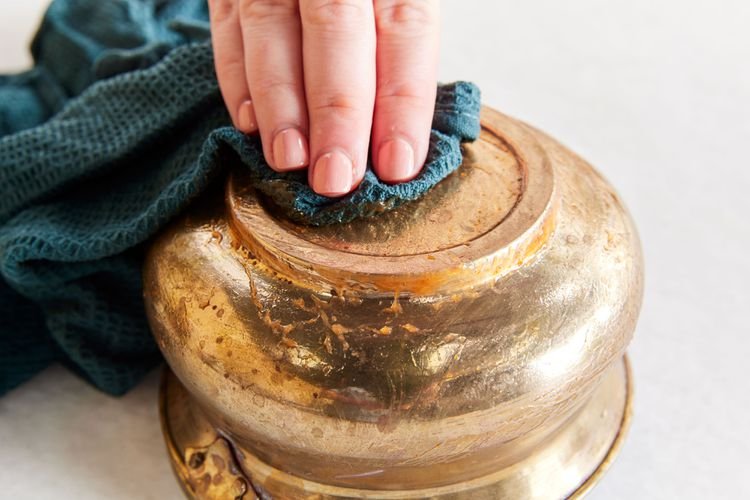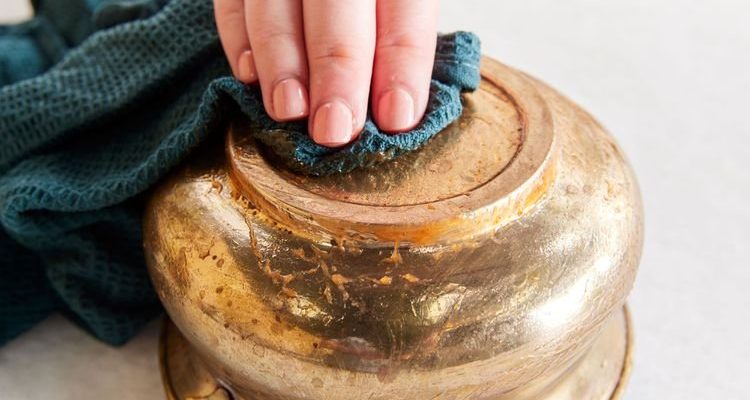
Here’s the thing: brass is beautiful, but it’s also needy. Unlike stainless steel or plastic, polished brass can tarnish and lose its shine fast, especially when it’s out in the weather or touched often. And while brands like Baldwin or Schlage are known for their durable brass finishes, even the best polish won’t keep forever. The good news? You can get that mirror-like shine back—and keep it looking good—with just a few household supplies and some patience.
Why Brass Kick Plates Lose Their Shine
Let me explain why polished brass kick plates lose their sparkle in the first place. Brass is a metal alloy, mostly made of copper and zinc. When exposed to air, moisture, and oils from our skin, brass reacts—technically, it oxidizes. This oxidation creates tarnish: a dull, often greenish or brownish layer. If you’ve ever seen an old penny, you know the look.
You might be wondering if all kick plates will tarnish the same way. Honestly, not quite. Some brands apply a clear lacquer coating to protect the shiny finish. But once that coating wears down (from regular door kicks or cleaning with harsh products), the raw brass is left to fend for itself. Factors like weather exposure, humidity, and how much you touch the plate all play a role. Even the direction your door faces can speed up tarnishing if it gets direct sunlight or rain.
Dirt is another culprit. Muddy shoes, pet paws, and blowing dust can leave fine scratches or a dirty film. Sometimes, what looks like tarnish is just built-up grime. That’s why your cleaning method matters—a lot.
Is Your Brass Kick Plate Solid or Plated?
Before you grab the polish, you’ll want to know what you’re dealing with. Not all brass kick plates are made the same way.
Solid brass plates are durable and can be cleaned and polished many times. No matter how many layers you remove, you’ll still have beautiful brass underneath. But brass-plated plates have only a thin layer of brass over another metal (like steel or zinc). If you scrub too hard or use aggressive polish, you might actually rub through the brass layer, leaving behind a patchy, ugly spot that can’t be fixed.
Here’s how to check:
- Place a small magnet on your kick plate. If it sticks, it’s probably brass-plated steel. If it doesn’t, you likely have solid brass.
- Look for a label or manufacturer’s stamp on the edge or back. Brands like Baldwin or Deltana often mark their solid brass products.
- Check the weight. Solid brass tends to be heavier than plated alternatives.
Pro tip: Brass-plated kick plates need extra care. Stick with gentle cleaning—no steel wool, abrasive powders, or harsh chemicals.
Gathering Your Cleaning and Polishing Supplies
Getting the right supplies makes the whole job smoother. You don’t need anything rare or expensive, but what you use does matter—especially if you want to avoid scratches or dull spots.
Here’s the go-to cleaning kit for most brass kick plates:
- Soft microfiber cloths (for cleaning and buffing)
- Mild soap (like dish liquid) and warm water
- Baking soda and lemon juice (for homemade brass cleaner)
- Commercial brass polish (like Brasso or Weiman Brass Polish, only if your plate is solid brass)
- Old toothbrush or soft-bristled brush (for crevices and edges)
- Non-abrasive sponge
- Painter’s tape (to protect surrounding wood or paint)
- Gloves (optional, but keeps fingerprints off and protects your skin)
Skip steel wool, scouring pads, or anything meant for deep scrubbing. Those can leave hairline scratches. And if you have a lacquer-coated plate, avoid any cleaner that says “removes lacquer.” You want to preserve that top layer as long as possible.
How To Clean A Polished Brass Kick Plate: Step-By-Step
Now for the fun part: getting that kick plate bright again. If you’ve never done this before, don’t worry. Here’s a step-by-step that works whether your plate is Baldwin, Schlage, or another major brand.
Step 1: Remove Loose Dirt
Start by wiping the plate gently with a dry microfiber cloth. This removes dust, grit, and loose dirt—so you don’t accidentally scratch the finish in the next steps. Pay extra attention to the edges and corners. If your plate is especially grimy (think mud after a rainy day), use a soft brush to loosen stubborn bits.
Step 2: Wash With Mild Soap and Water
Mix a few drops of dish soap with warm water in a small bowl. Dip your cloth or sponge in the solution, wring it out, and gently wipe the entire kick plate. This lifts away old fingerprints, food oils, or anything sticky. Don’t flood the area—extra water can seep behind the plate and cause long-term issues. Rinse your cloth with clean water and wipe off any soap residue.
Step 3: Deal With Tarnish and Stubborn Spots
This is where you restore the shine. If your plate is solid brass and lacquer-free, you can use commercial brass polish. Follow the label instructions, usually rubbing a little polish with a clean cloth, then buffing to a shine.
For a gentler, homemade touch:
- Mix a paste of baking soda and lemon juice (or vinegar). It should be thick, not runny.
- Apply the paste to the brass, let it sit for 5–10 minutes, then gently rub in circles with your cloth.
- Wipe clean with a damp cloth, then dry thoroughly.
If your plate is brass-plated, stick with soap and water, or use a diluted vinegar solution (one part vinegar to 10 parts water) for light tarnish. Avoid any abrasive polishes.
Step 4: Buff and Restore the Shine
Honestly, this is the satisfying part. Take a dry, soft microfiber cloth and buff the brass in gentle circles. This brings out the shine and removes any leftover streaks. For extra gloss, you can use a clean part of your cloth and buff a second time—think of it like shining shoes.
If your kick plate still looks dull and you know it’s solid brass, you can repeat the polish process. Just give it time to dry between rounds.
How To Protect Your Brass Kick Plate After Cleaning
You might be thinking, “Great, it’s shiny…but won’t it just tarnish again?” You’re right—brass is always fighting a losing battle with the elements. But you can slow down the process.
Here are a few easy tips to keep your kick plate looking sharp:
- Apply a protective wax (like car wax or clear paste wax) after polishing. Rub on a thin layer, let it dry, then buff. This forms a water-resistant barrier.
- Avoid harsh cleaners or anything labeled “degreaser.” These strip away protective coatings.
- Clean fingerprints and dirt regularly. The less time grime sits, the less it can dull the finish.
- Consider a re-lacquer kit if your plate was originally coated. These can give months of protection, but be sure your kick plate is clean and dry before applying.
If your entryway sees a ton of rain or snow, a covered porch or door awning can also help protect the metal.
Common Problems: Scratches, Stains, and Dull Spots
Even if you’re careful, brass kick plates can still get scratched, stained, or develop stubborn dull areas. Let me walk you through fixing some of the most common issues.
- Fine scratches: Use a special brass polish and a very soft cloth. Buff gently in the direction of the scratch. Don’t rub in circles—this can make it more visible. If it’s a deep scratch and your plate is solid brass, you may be able to sand it lightly with extra-fine (1500-grit) sandpaper, but this is risky and not recommended for beginners.
- Water spots or cloudy stains: These usually come from minerals in rain or tap water. Try wiping with a vinegar-water mix (again, dilute!) and buff dry. For persistent stains, commercial brass polish is your friend—just double-check that your plate is solid brass.
- Dull patches: Sometimes, these are spots where wax or lacquer has worn away. Clean and polish as above, then apply a thin layer of protective wax to match the shine.
Heads up: If you accidentally strip too much lacquer from a coated plate, you might need to remove the plate and have it professionally refinished.
Alternatives For Severely Damaged Brass Kick Plates
You might reach a point where cleaning and polishing just aren’t enough. Maybe the brass is pitted, the plating is worn through, or the whole thing just looks beyond saving. Don’t worry, you’ve got options.
- Replacement: Sometimes, swapping out the kick plate is easier and more cost-effective than restoring it. Most hardware stores carry universal and brand-specific replacements (like Baldwin or Schlage), usually pre-polished and coated for durability.
- Professional refinishing: If your kick plate is valuable, custom, or sentimental, a metal refinishing pro can strip, polish, and re-lacquer it. This usually costs less than you think, and the results can be stunning.
- Brass plating kits: If you’re hands-on and the plate is only lightly worn, some DIY kits let you re-plate brass at home. Just proceed with caution—results can be hit or miss unless you’re meticulous.
If you’re replacing, measure your old plate carefully. Most brands list the length and width in inches, and some doors need custom sizes. Universal plates are easy to fit, but branded ones may match the original finish or screw pattern better.
How To Keep Your Polished Brass Kick Plate Looking Great
Once you’ve put in the work, you’ll want that shine to last. Here’s a simple upkeep routine that works for most homes:
- Quick wipe weekly: Run a microfiber cloth over the plate as you clean your door. No need for soap unless it’s grimy.
- Full cleaning every 1–2 months: Use mild soap and water, then buff dry. Polish and wax if needed.
- Check and touch up the finish: If you see spots of dullness or wear, polish just those areas. Don’t wait until it’s fully tarnished.
- Inspect for scratches or loose screws: Tighten hardware and buff out minor scratches before they get worse.
Honestly, a little regular TLC beats one big, messy cleaning marathon every year.
Final Thoughts: Enjoy That Brass Shine
Polished brass kick plates might seem high-maintenance, but the payoff is real—a freshly shined kick plate gives your front door that “just moved in” look. Whether yours is a Baldwin, Schlage, or another trusty brand, the cleaning and restoration process is all about patience and the right tools. Work gently, use the right supplies, and don’t rush—your brass will thank you with a reflective, golden glow that makes every entryway feel just a little bit fancier. And if you keep up with regular care, you’ll spend less time scrubbing and more time enjoying that eye-catching shine.
